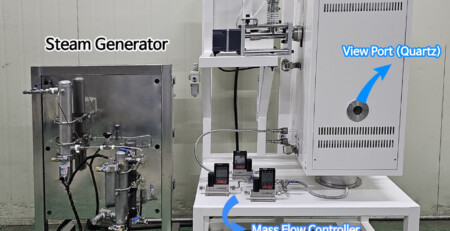Tube Furnace for Silicon Wafer Preparation
Background: Semiconductor Export Controls
In October 2022, the US Department of Commerce announced sweeping restrictions to limit China’s access to the microchips that facilitate AI and supercomputing. Under these new export controls, American firms will need a license to sell certain chips and other components to the Chinese market. Moreover, foreign firms will need a similar license to use American equipment or software in the production of China-bound chips.
The restrictions are intended to impede China’s development of advanced military and surveillance technologies amid ongoing trade and geopolitical tensions between the two countries. Although China is rapidly expanding the scale and sophistication of domestic chip production, it remains dependent on foreign suppliers. For instance, today’s most advanced semiconductors and their requisite machines come from Taiwan and the Netherlands, respectively.
Effects on US chip manufacturers are difficult to predict, especially in light of potential retaliatory measures. However, we expect large US firms to seek stateside alternatives as their Chinese buyers and suppliers become less accessible.
Likewise, we anticipate that US semiconductor labs will expedite research, fueled by further capital investment. Cost-effective, high-performance lab equipment will be key to responding quickly to changing trade regulations and a more volatile global semiconductor market.
Tube Furnaces & Silicon Wafer Preparation
Silicon wafer production is, of course, a basic necessity for microchip R&D. In laboratory settings, one common technique is dry oxidation. It typically demands a quartz tube furnace for precise temperature and atmospheric control under very high heat.
Wafer production begins with a uniquely defect-free silicon ingot known as a boule. In research settings, it’s often 100 mm in diameter, although 300 mm is the standard for commercial production.
The boule gets sliced into discs approximately 1 mm thick, each of which is extensively machined and polished to yield an immaculately finished wafer.
The wafer now resembles its final form, but it’s not a semiconductor yet. That requires the tightly controlled introduction of some impurities. In this case, high-temperature oxidation creates silicon dioxide—and that’s where tube furnaces are indispensable.
Wafer oxidation is a delicate process that requires painstakingly slow heating to a final temperature of 800°–1200° C. The upper end of that range is perhaps most often used, but the lower end yields thinner and more stable oxides.
In addition, the technician needs to prevent premature oxidation by flushing the chamber with N2 before and while the wafers are brought up to temperature. Oxygen is introduced only once the furnace is sealed and the wafers have reached the target temperature.
Tube Furnace Design Considerations
Whatever the target temperature, it’s critical to ramp up by as little as a few degrees per minute. More aggressive heating is liable to create a temperature differential that warps or cracks the wafer, rendering it useless.
Our tube furnaces mitigate this risk thanks to two key features: multiple hot zones and automatic sliding.
With three zones of 200 mm in length, users can maximize throughput by setting a single temperature across 600 mm, or maximize ramp rate precision by setting a temperature gradient.


In either case, the hot zones are managed by a programmable controller with up to 45 custom steps (optionally pre-programmed by an SH engineer, upon request). This allows for countless and perfectly repeatable combinations of heating rates and holding times.
Regardless of the hot zone configuration, it’s essential to heat the wafers slowly.
Typically, the wafers rest on a carrier known as a boat. The boat, in turn, sits on an arm that a technician can slide slowly into the furnace. That is the primary technique to ensure gradual heating. Unfortunately, it’s cumbersome for the technician (who must continually attend to the wafers while wearing a heavy, heat-resistant glove) and somewhat prone to variation.
Upon request, SH tube furnaces are available with an automatic sliding mechanism for consistent, hands-off heat introduction. Combined with independent hot zone programming, this gives effectively unlimited control over every stage of heating.
Each furnace also features proprietary end seals that unlock and open in just a couple steps. They make for quick, easy loading and unloading, unlike others that require disassembling the entire seal and flange. In fact, our end seals are a popular standalone upgrade among labs that have grown frustrated with sample insertion/removal with a non-SH furnace.
Why Use an SH Scientific Tube Furnace?
Our in-house engineering and production resources are dedicated to custom manufacturing for laboratories.
Unlike larger furnace suppliers with prohibitive minimum order quantities (MOQs) and sky-high marketing expenses, our entire business is oriented around making custom requests surprisingly affordable.
In fact, our most extensively customized tube furnaces are often similar in price to other manufacturers’ base models.


Common customizations for microchip labs
Most laboratories prefer a three-hot-zone configuration with programmable digital controllers, for more granular heat control.
In addition, automatic sliding is a valuable and reliable workflow improvement.
Most significantly, the typical ingot size of 100 mm (for R&D purposes) calls for a tube diameter of 120 mm. But many facilities handle far larger ingots, at which point tube furnaces often become cost-prohibitive. Upon request, we can produce accessibly priced furnaces with custom tube diameters to accommodate wafers well over 300 mm.
To the best of our knowledge, SH Scientific is the only manufacturer to offer three-zone tube furnaces with full customization.
SH tube furnaces in the real world
If you’re curious how affordably you can ramp up silicon wafer preparation, then contact our USA sales office to request a custom quote.
We’re proud to supply dozens of US academic, research, and defense labs with reliable tube furnaces and other key equipment.










